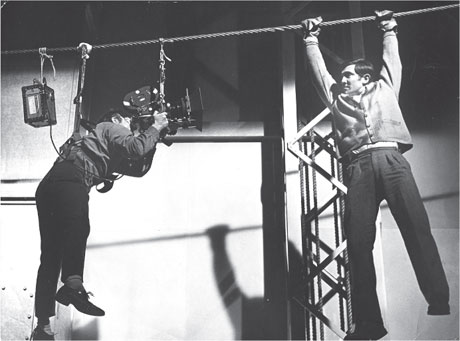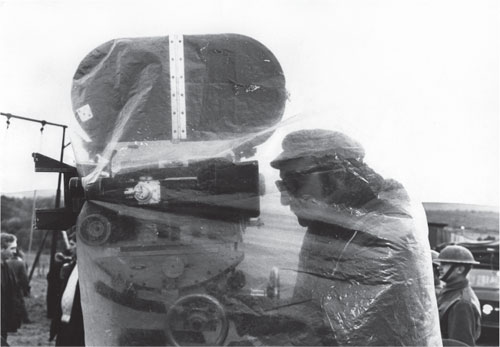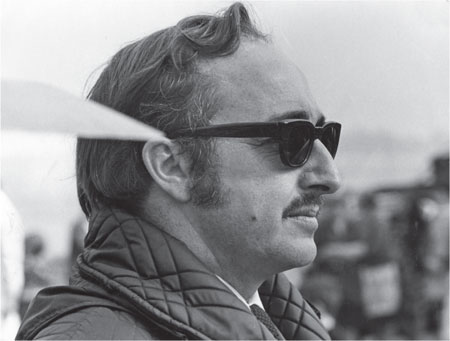Read Shooting 007: And Other Celluloid Adventures Online
Authors: Sir Roger Moore Alec Mills
Shooting 007: And Other Celluloid Adventures (17 page)

Looking back on past experiences as youth gives way to awareness, perhaps
The Saint
was a necessary learning curve that taught me to accept disappointment even while I was enjoying a small measure of success. Operating the camera on a television series would bring out the confidence in me which had somehow been missing; a year’s experience behind the camera sorted that trouble out before the series finally came to an end. I now look upon it as my dress rehearsal.
Michael had worked for Peter Hunt before. Peter, an editor of much repute for his slick work on the James Bond films, was now directing the opening sequence of
Chitty Chitty Bang Bang
while I tagged along as camera operator. You can probably understand my frustration when Peter suggested that I should operate the camera ‘badly’, allowing the racing cars to disappear out of frame before panning to catch them up, which happened to cameramen in days gone by and was probably just as frustrating for the viewers. We also filmed speed trials at a Formula One race in Monte Carlo for a film soon to start; my position was in the tunnel, where I remember experiencing the pain of the unbelievable noise even when wearing ear defenders for protection. It was another rare and unforgettable experience – but sadly the film never happened in the end.
The
Chitty Chitty Bang Bang
sequence would take a month to film, allowing time for Peter and Michael to build a strong professional relationship, with Peter offering Michael his next film
On Her Majesty’s Secret Service
. This film would be the turning point in both our careers, although in the end it would not work out as we would have wished or hoped. Even so, our careers were now moving to a different level, working with a gentleman going by the name of James Bond.
Before this excitement could be realised, Sean Connery, tired of the part after five films, decided to abandon the coveted role of agent 007. So a new James Bond needed to be found, tested and photographed for looks, physique and personality – all the qualities of his predecessor. It was even more important to see how the new secret agent came across on the screen, with three candidates being put to the test before an unknown Australian model was named ‘the chosen one’.

Filming in the cable car winding house of Blofeld’s Piz Gloria lair. This sequence was actually filmed on a mechanism designed by special effects supervisor John Stears on a stage at Pinewood Studios, so I was not quite so high off the ground as it appears, but when being winched towards the giant cog wheels at 15mph. I still needed to be confident that the cable would stop at exactly the right time and place. (© 1969 Danjaq, LLC and United Artists Corporation. All rights reserved)
George Lazenby’s claim to fame may have come from a television commercial featuring images of a handsome man carrying a big wooden crate of Big Fry chocolate on his shoulder; another account suggests that Cubby Broccoli had met George in a barber’s shop somewhere in London. Whatever the truth, this would be something of a gamble with George now suddenly in the public eye. From now on a hungry press would follow his every move as the new 007, which sadly ended in his downfall. Peter Hunt tried to protect him from all of the negative publicity to which he would be exposed, but George ignored the director’s protection by playing James Bond off screen as well as on, making himself an easy target for the press – game over!
George’s transgressions may have been forgiven and put down to inexperience, but he would seal his own fate while on location in Portugal when he decided to go horse riding. Cubby Broccoli paced up and down waiting on George’s return to the set, breathing fire and speaking to no one, his expression clearly suggesting that George was in big trouble for his irresponsible behaviour, the consequence of which would not bear thinking about should he have had an accident. Actors have personal responsibilities to look after themselves when working on films, considering all that could happen should anything go wrong; George’s immature folly had also kept the entire unit and the professional Diana Rigg waiting on set for his return.
It would not come as a surprise to learn that George would not appear a second time as agent 007. Given time and coaching, he might have developed further as an actor and gained an understanding and respect of the responsibilities to which all actors must adhere. George would perhaps have made a great James Bond, but his temperament and this thoughtless act of riding a horse would only leave him with wonderful memories and time to reflect on all of the possibilities.
Lazenby’s Bond received mixed reviews from the press, which at the time I believed to be fair, while Diana Rigg’s Tracy would keep our hero’s sexual activities restrained before they got married. The dramatic ending comes with Mr and Mrs Bond driving off on their honeymoon, where Tracy is murdered by 007’s arch-enemy Ernst Stavro Blofeld, played by Telly Savalas.
Of the many countries and locations I had the privilege of visiting throughout my career, the Switzerland location of Murren-Schilthorn will be one best remembered, not only for its perfect climate but also for the fantastic atmosphere in this fabulous skiing resort. Suzy and I recently returned to the Jungfrau mountain where we filmed the sequences and destruction of Blofeld’s lair Piz Gloria – memory lane time! The slowly revolving restaurant at the summit now treats visitors to the beauty of the surrounding snow-covered mountains, majestic in their glory, allowing those wonderful memories to flow back.
In today’s film industry the name Michael Reed hardly features in the minds of young wannabe cinematographers, but what they will remember was Michael’s stunning cinematography of
On Her Majesty’s Secret Service
, which was as beautiful as the compliments shown him on both sides of the Atlantic.
I should also mention Willy Bogner’s skiing skills on the second unit. His work was truly outstanding at times, with the camera strapped between his legs while he was towed behind a bobsleigh on a bob run. His efforts must be seen to be believed.
Over the years, Michael and I shared a wonderful working relationship, with our families also enjoying the good times together, but December brings a period in the calendar when film production remains traditionally quiet – a situation that could perhaps go on well into the New Year! With little prospect of work, it is necessary to tighten belts as the Christmas holiday gets closer, which could be particularly worrying when there were rumours that it could be the spring before the industry returned to normal. Even so, an upbeat Michael called me with the news of the offer of a film in Spain, which would start early in the New Year. It was called
The Hunting Party.
Having read the script – a western – Michael thought it was an exciting story with a strong cast, including Gene Hackman, Candice Bergen and Oliver Reed. In this positive mood he arranged for a script to be sent to me from Madrid, which arrived a few days later. I phoned Michael, agreeing that it was an exciting idea, although privately I was surprised that he would be interested in a subject such as this. Anyway, no more attention was paid to this particular observation.
When Mike and wife Jill joined the Mills family in celebration over dinner the atmosphere was relaxed with the prospect of a film in the New Year. The contented smiles around the table reflected that belts could now be loosened. All seemed well, until during the meal Michael asked my opinion of the script. I had of course assumed my copy to be the same as his, and I carefully mentioned that I was surprised he would be interested in a subject such as this. My honest reply came as a surprise to Michael, who looked at me, uncertain why I would say this, leaving me in a tight corner with his next obvious question.
‘Why do you say that?’

The McKenzie Break
filmed in Ireland in 1968 was a happier production with Mike Reed compared to the misery of
The Hunting Party
. Ireland has always been famous for its rain and the camera cover, if not comfortable, at least kept me dry!
The table went quiet waiting on my nervous reply.
‘Well … I suppose it was the rape scene, the scenes with the kidnapping of ...’
He stopped me before I went any further, wanting to see my script.
At first Michael had thought I was pulling his leg, he was well aware of my weird sense of humour and that I could have been playing one of my silly games on him, but not this time. This time I was serious. Michael quickly flipped through the pages before deciding that it was not the time or place to read the script and said that he would take it home to read later. At this point alarm bells were ringing.
The next morning Michael called with the news that he had already phoned the production office in Madrid and pulled out of the project! I could hardly believe what I was hearing as neither of us could afford the luxury of losing a film such as this; times had been quiet and we both had mortgages to consider, so none of this made any sense. More questions – selfish questions.
Michael clearly understood what had happened. It would seem that the production company had sent a script to Michael that was considerably different to mine. We never knew if this was intentional on their part or not, but either way it did not matter now as my friend had withdrawn from the film out of personal principles concerning the subject matter, beliefs which would not allow him to pursue this project any further. He immediately suggested that I should not withdraw from the film just because of his moral viewpoint – his personal commitment. Perhaps my dedication to principle was not as strong as Michael’s, which in time I will surely pay for, but I really could not afford to lose the work, believing that my family came first, which no doubt makes me the lesser man.

The nose gets more bent as time moves on, though still quite handsome. It’s curious how so many people have said that I reminded them of Peter Sellers.
It happened that in the end Michael was very fortunate in his decision not to take the job, leaving me to wonder if an outside force was protecting my friend while my penance would be to work on the film and experience the consequences.
The
Hunting Party
was by far the most unhappy film I ever worked on, with a dreadful atmosphere existing throughout our filming – a situation created entirely by the director, Don Medford. The chemistry between Dick Bush, Michael’s replacement as cameraman, and Medford was next to zero and within two weeks Dick had been replaced with the Spanish cinematographer Cecilio Paniagua. The new arrival, a quiet, pleasant gentleman, appeared to meet the director’s approval by sensibly staying clear of Medford’s dangerous shadow, but even so the story does not end there. The American actor Mitchell Ryan, with whom we had filmed for the past two weeks, was next in line for the chop. Like Dick Bush, he would suddenly disappear overnight, so that at breakfast the crew would look around the table to see who was missing.


